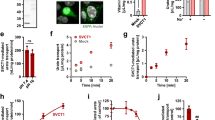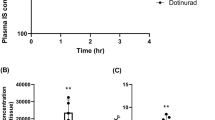Abstract
Urate is the major inert end product of purine degradation in higher primates in contrast to most other mammals because of the genetic silencing of hepatic oxidative enzyme uricase. The kidney plays a dominant role in urate elimination. The kidney excretes 70% of the daily urate production. Therefore, it is important to understand renal urate handling mechanism because the under excretion of urate has been implicated in the development of hyperuricemia that leads to gout. The urate transport systems exist in the proximal tubule but they are complicated because of their bidirectional transport and the species differences. Recently, we have identified the urate-anion exchanger URAT1 (SLC22A12) in the human kidney and found that defects in SLC22A12 lead to idiopathic renal hypouricemia. URAT1 is targeted by uricosuric and antiuricosuric agents that affect urate excretion. Molecular identification of urate transporting proteins will lead to the new drug development for hyperuricemia.
Similar content being viewed by others
References and Recommended Reading
Sica DA, Schoolwerth AC: Renal handling of organic anions and cations: excretion of uric acid. In The Kidney, edn 6. Edited by Brenner BM. Philadelphia: WB Saunders; 2000:680–700. This book described various aspects of urate transport in the kidney depend on the classical experimental data.
Maesaka JK, Fishbane S: Regulation of renal urate excretion: a critical review. Am J Kidney Dis 1998, 32:917–933.
Abramson RG, Lipkowitz MS: Evolution of the uric acid transport mechanisms in vertebrate kidney. In Basic Principles in Transport, Comp Physiol, vol 3. Edited by Kinne RKH. Basel, Switzerland: Karger, 1990:115–153.
Enomoto A, Kimura H, Chairoungdua A, et al.: Molecular identification of a renal urate anion exchanger that regulates blood urate levels. Nature 2002, 417:447–452. This work was the breakthrough for the understanding of the renal urate transport mechanisms.
Kang DH, Nakagawa T, Feng L, et al.: A role of uric acid in the progression of renal disease. J Am Soc Nephrol 2002, 13:2888–2897.
Johnson RJ, Kang DH, Feig D, et al.: Is there a pathogenic role for uric acid in hypertension and cardiovascular and renal disease? Hypertension 2003, 41:1183–1190.
Aruoma OI, Halliwell B: Inactivation of alpha 1-antiproteinase by hydroxyl radicals. The effect of uric acid. FEBS Lett 1989, 244:76–80.
Kaur H, Halliwell B: Action of biologically-relevant oxidizing species upon urate. Identification of urate oxidation products. Chem Biol Interact 1990, 73:235–247.
Hooper DC, Spitsin S, Kean RB, et al.: Uric acid, a natural scavenger of peroxynitrite, in experimental allergic encephalomyelitis and multiple sclerosis. Proc Natl Acad Sci U S A 1998, 5:675–680.
Spitsin SV, Scott GS, Mikheeva T, et al.: Comparison of uric acid and ascorbic acid in protection against EAE. Free Radic Biol Med 2002, 33:1363–1371.
Hellsten Y, Tullson PC, Richter EA, Bangsbo J: Oxidation of urate in human skeletal muscle during exercise. Free Radic Biol Med 1997, 22:169–174.
Kikuchi Y, Koga H, Yasutomo Y, et al.: Patients with renal hypouricemia with exercise-induced acute renal failure and chronic renal dysfunction. Clin Nephrol 2000, 53:467–472.
Igarashi T, Sekine T, Sugimura H, et al.: Acute renal failure after exercise in a child with renal hypouricemia. Pediatr Nephrol 1993, 7:292–293.
Ishikawa I, Sakurai Y, Masuzaki S, et al.: Exercise-induced acute renal failure in 3 patients with renal hypouricemia. Nippon Jinzo Gakkai Shi 1990, 32:923–928.
Murakami T, Kawakami H, Fukuda M, Shiigi H: Recurrence of acute renal failure and renal hypouricemia. Pediatr Nephrol 1993, 7:772–773.
Berlinger RW, Hilton JG, Yü TF, Kennedy TJJr: The renal mechanism for urate excretion in man. J Clin Invest 1950, 9:396–401.
Roch-Ramel F, Guisan B: Renal transport of urate in humans. News Physiol Sci 1999, 14:80–84. {xmThis paper re-evaluated the 4-component theory using human BBM vesicles}.
Sekine T, Cha SH, Endou H: The multispecific organic anion transporter (OAT) family. Pflügers Arch 2000, 440:337–350.
Koepsell H, Endou H: The SLC22 drug transporter family. Pflügers Arch 2004, 447:666–676. This is an excellent review of organic anion/cation transporters concerning the molecular identification of them.
Hosoyamada M, Sekine T, Kanai Y, Endou H: Molecular cloning and functional expression of a multispecific organic anion transporter from human kidney. Am J Physiol Renal Physiol 1999, 276:F122-F128.
Ichida K, Hosoyamada M, Kimura H, et al.: Urate transport via human PAH transporter hOAT1 and its gene structure. Kidney Int 2003, 63:143–155.
Cha SH, Sekine T, Fukushima JI, et al.: Identification and characterization of human organic anion transporter 3 expressing predominantly in the kidney. Mol Pharmacol 2001, 59:1277–1286.
Bakhiya N, Bahn A, Burckhardt G, Wolff NA: Human organic anion transporter 3 (hOAT3) can operate as an exchanger and mediate secretory urate efflux. Cell Physiol Biochem 2003, 13:249–256.
Kimura H, Ichida K, Hosoyamada M, et al.: Analysis of uric acid transport via hOAT3. Gout Nucleic Acid Metab 2000, 24:115–121.
Cha SH, Sekine T, Kusuhara H, et al.: Molecular cloning and characterization of multispecifc organic anion transporter 4 expressed in the placenta. J Biol Chem 2000, 275:4507–4512.
Ekaratanawong S, Anzai N, Jutabha P, et al.: Human organic anion transporter 4 is a renal apical organic anion/dicarboxylate exchanger in the proximal tubules. J Pharmacol Sci 2004, 94:297–304.
Kimura H, Ichida K, Hosoyamada M, et al.: Urate transport via hOAT4. Gout Nucleic Acid Metab 2001, 25:113–120.
Roch-Ramel F, Werner D, Guisan B: Urate transport in brush-border membrane of human kidney. Am J Physiol 1994, 266:F797-F805.
Prabhakaran D, Anand SS: The metabolic syndrome: an emerging risk state for cardiovascular disease. Vasc Med 2004, 9:55–68.
Online Mendelian Inheritance in Man: http:// www.ncbi.nlm.nih.gov/entrez/query.fcgi?db=OMIM
Yeun JY, Hasbargen JA: Renal hypouricemia: prevention of exercise-induced acute renal failure and a review of the literature. Am J Kidney Dis 1995, 25:937–946.
Hisatome I, Ogino K, Saito M, et al.: Renal hypouricemia due to an isolated renal defect of urate transport. Nephron 1988, 49:81–83.
Shichiri M, Matsuda O, Shiigai T, et al.: Renal tubular hypouricemia: evidence for defect of both secretion and reabsorption. Arch Intern Med 1982, 142:1855–1857.
Komoda F, Sekine T, Inatomi J, et al.: The W258X mutation in SLC22A12 is the predominant cause of Japanese renal hypouricemia. Pediatr Nephrol 2004, 19:728–733.
Tanaka M, Itoh K, Matsushita K, et al.: Two male siblings with hereditary renal hypouricemia and exercise-induced ARF. Am J Kidney Dis 2003, 42:1287–1292.
Ichida K, Hosoyamada M, Hisatome I, et al.: Clinical and molecular analysis of patients with renal hypouricemia in Japan-Influence of URAT1 gene on urinary urate excretion. J Am Soc Nephrol 2004, 15:164–173.
Iwai N, Mino Y, Hosoyamada M, et al.: A high prevalence of renal hypouricemia caused by inactive SLC22A12 in Japanese. Kidney Int 2004, 66:935–944.
Lipkowitz MS, Leal-Pinto E, Cohen BE, Abramson RG: Galectin 9 is the sugar-regulated urate transporter/channel UAT. Glycoconj J 2004, 19:491–498.
Rafey MA, Lipkowitz MS, Leal-Pinto E, Abramson RG: Uric acid transport. Curr Opin Nephrol Hypertens 2003, 12:511–516.
Jutabha P, Kanai Y, Hosoyamada M, et al.: Identification of a novel voltage-driven organic anion transporter present at apical membrane of renal proximal tubule. J Biol Chem 2003, 278:27930–27938.
VanAubel RA, Smeets PH, van den Heuvel JJ, Russel FG: Human organic anion transporter MRP4 (ABCC4) is an efflux pump for the purine end metabolite urate with multiple allosteric substrate binding sites. Am J Physiol Renal Physiol 2005, 288:F327-F333.
Rampoldi L, Caridi G, Santon D, et al.: Allelism of MCKD, FJHN and GCKD caused by impairment of uromodulin export dynamics. Hum Mol Genet 2003, 12:3369–3384. This work added novel aspect for renal urate handling.
Hung AY, Sheng M: PDZ domains: structural modules for protein complex assembly. J Biol Chem 2002, 277:5699–5702.
Anzai N, Miyazaki H, Noshiro R, et al.: The multivalent PDZ domain-containing protein PDZK1 regulates transport activity of renal urate-anion exchanger URAT1 via its C-terminal. J Biol Chem 2004, 279:45942–45950. This paper described the importance of protein-protein interaction in the functional regulation of urate transporter.
Kocher O, Comella N, Tognazzi K, Brown LF: Identification and partial characterization of PDZK1: a novel protein containing PDZ interaction domains. Lab Invest 1998, 78:117–125.
Dev KK: Making protein interactions druggable: targeting PDZ domains. Nat Rev Drug Discov 2004, 3:1047–56.
Hosoyamada M, Ichida K, Enomoto A, et al.: Function and localization of urate transporter 1 in mouse kidney. J Am Soc Nephrol 2004, 15:261–268.
Li T, Walsh JR, Ghishan FK, Bai L: Molecular cloning and characterization of a human urate transporter (hURAT1) gene promoter. Biochim Biophys Acta 2004, 1681:53–58.
Gopal E, Fei YJ, Sugawara M, et al.: Expression of slc5a8 in kidney and its role in Na(+)-coupled transport of lactate. J Biol Chem 2004, 279:44522–44532. This paper clarified the important pathway to support renal apical urate transport systems.
Zandi-Nejad K, Plata C, Enck AH, et al.: Slc5a8 functions as a sodium-dependent pyrazionate and nicotinate cotransporter; Implications for renal urate transport. J Am Soc Nephrol 2004, 15:89A.
Author information
Authors and Affiliations
Rights and permissions
About this article
Cite this article
Anzai, N., Enomoto, A. & Endou, H. Renal urate handling: Clinical relevance of recent advances. Curr Rheumatol Rep 7, 227–234 (2005). https://doi.org/10.1007/s11926-996-0044-0
Issue Date:
DOI: https://doi.org/10.1007/s11926-996-0044-0




